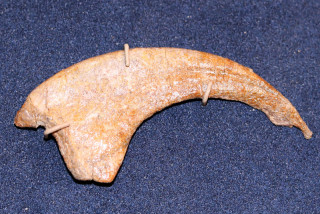Explorer Corps Marker: Grand County
Find the Marker
The Grand County marker is in front of the Moab Museum at 118 E Center Street in Moab. It highlights Utahraptor ostrommaysi, Utah’s State Dinosaur.
GPS 38°34’23.7252”N 109°32’53.9592”W
Dig Deeper
When you travel towards the outpost town of Moab, surrounded by mile upon mile of red rock wilderness, try to put your mind back in the Early Cretaceous Period. Back then, more than 126 million years ago, the area that’s now desert was instead dotted with towering conifer trees and carpets of ferns alongside braided streams. This was the habitat of one of the largest raptor dinosaurs ever found – Utahraptor ostrommaysi.

Reaching more than 20 feet from the tip of their snout to the end of their tail, adult Utahraptor were among the largest carnivorous dinosaurs of their time. This was no turkey-sized hunter, like its small cousin Velociraptor, but a predator capable of pinning down large prey with the distinctive, nine-inch-long killing claws Utahraptor bore on each foot.
“All Utahraptor specimens to date have only been found in the lowermost rock layers of the Cedar Mountain Formation in Grand County, Utah,” says Dr. Randall Irmis NHMU's chief curator and curator of paleontology. In fact, this place is quite a dinosaur hotspot. Excavations of the Cedar Mountain Formation in Grand County have turned up multiple new species, some of which still await formal description.
The path of Utahraptor from bones in stone to paleontological superstar began thirty years ago. Even though a few Utahraptor bones had been found in 1975, these fossils were never named or described. It wasn’t until 1991, Irmis notes, that now-state paleontologist James Kirkland found a partial skeleton of a carnivorous dinosaur in the Early Cretaceous rocks of Grand County. These bones, along with a new analysis of earlier finds, led to the description of Utahraptor in 1993 – the same year that Jurassic Park and its larger-than-life raptors were tearing across movie screens.
To date, Utahraptor has only been found in Utah. With that distinction, Utahraptor was honored as Utah’s State Dinosaur in 2018 and plans are currently afoot to establish a Utahraptor State Park in the vicinity of where the dinosaur was found. But paleontologists are still learning more about this dinosaur.
In 2015 Kirkland and colleagues excavated a nine-ton block of sandstone containing multiple Utahraptor fossils, including bones from raptors of all ages - full-grown adults to juveniles. “The bones from this block are very well-preserved, but quite fragile,” Irmis says. It will take years to prepare the fossils, remove them safely from the rock, and study them.
Still, Irmis notes, this new collection of Utahraptor bones has the potential to totally re-envision this stellar dinosaur. “The entire collection of fossils used to describe Utahraptor as a new species in 1993 could fit in a single dresser drawer,” Irmis says. The new fossils, however, “will provide a wealth of information” about the biology of the dinosaur – from what their skeletons really looked like to how these dinosaurs grew up.
Want to Go Farther?
When you're visiting the marker, you can see a cast of a leg of a Utahraptor at the Moab Museum. You can also visit the USU Eastern Prehistoric Museum in Price or the Natural History Museum of Utah in Salt Lake City to see Utahraptor fossils.